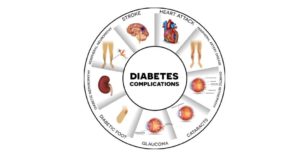
November is American Diabetes Month and Diabetic Eye Disease Month
If you haven’t had a dilated eye exam lately, November is an ideal time to make an appointment for one. It’s American Diabetes Month, and eye disease is one of the most common and debilitating complications of diabetes.
Diabetics have heard for years of the problems that could occur with their vision, and according to health experts, complacency is a pitfall. “Monitoring your eye health is critical if you’re a diabetic. We’ve said that for years, and I worry that the message may be ignored,” said ophthalmologist Alan Lacoste, MD; F.A.C.S with The Eye Clinic. “The vision problems diabetics are at risk for are very real.”
Regular eye exams are critical for effective diabetes management. In fact, once a diagnosis is received, it’s a good idea to make an appointment for an eye exam in order to see if any damage has already been done and to keep tabs on changes.
Eye doctors can also play a key role in reducing the impact of diabetes in individuals who are unaware they have the disease, because the early signs of diabetes can often be discovered during a dilated eye exam. “There have been many times when I’ve examined a patient and I can see the changes from diabetes in their eye, but they haven’t been diagnosed yet. I’ll talk with them and urge them to talk to their primary physician for follow-up,” says Dr. Lacoste.
The changes Dr. Lacoste is referring to occur due to blood sugar fluctuations. He explains that elevated blood sugar can cause the lens of the eye to swell, changing the ability to see clearly. Newly diagnosed diabetics may notice vision changes, if their blood sugar has been high for some time.
Diabetes is a significant contributing factor for three main vision problems:
Diabetic retinopathy. This is the leading cause of irreversible blindness in the United States. Damage to the blood vessels in the back of the eye is responsible for the vision loss, and it’s due to high blood sugar levels. Treatment usually involves laser surgery.
Glaucoma. People with diabetes are 40 percent more likely to have glaucoma than people without diabetes; and the longer someone has diabetes, the greater the chances of complications like glaucoma. Symptoms, such as tunnel vision, are usually a late finding. During an eye exam, the pressure in the eye is checked. If the pressure is thought to be too high for that patient, then it can be treated with eye drops, laser or more invasive types of surgery.
Cataracts. Diabetics are 60 percent more likely to develop cataracts, a clouding or fogging of the focusing lens in the eye. People with diabetes tend to get cataracts at an earlier age and they progress more rapidly than in people without diabetes. Blurred vision and problems with glare are the most reported symptoms. Surgery can usually restore clear vision; most patients report an improvement after surgery.
Dr. Lacoste says the impact of diabetes on eye health can be postponed by keeping blood sugar levels within the recommended guidelines. This involves a healthy eating plan, regular exercise and routine check ups with health providers, including eye exams. However, the number of years a patient has the disease remains one of the biggest reasons for complications. “Many of the vision problems have little to no symptoms at first, which means they can go unnoticed for years until it’s too late to reverse the damage. For patients who regularly have eye exams, we can notice small changes from year to year and take steps to hold onto the best vision possible,” Says Dr. Lacoste.
For more information about diabetes and your eyes, call 478-3810 or visit www.theeyeclinic.net.
